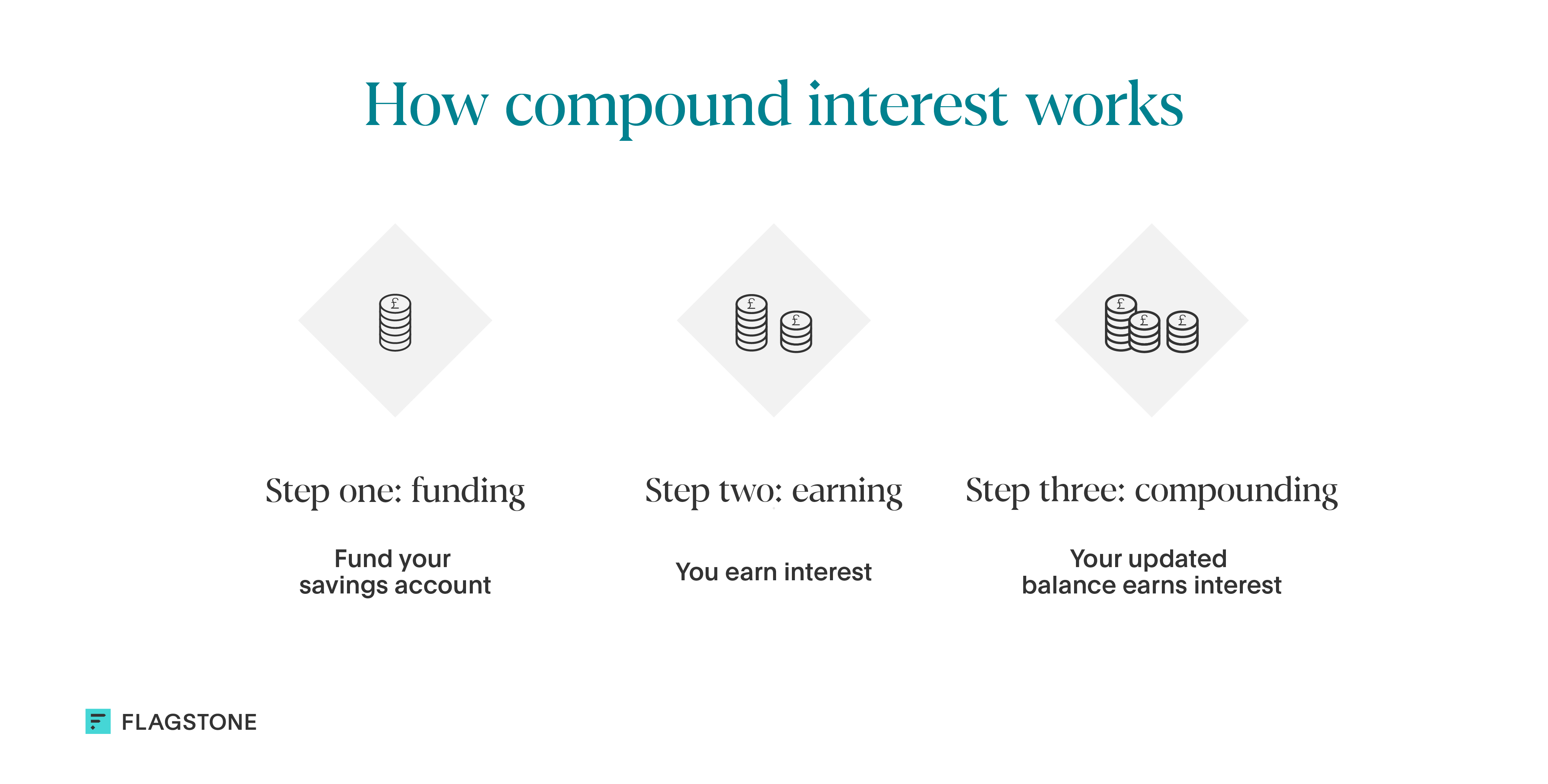The complete guide to tax-free savings in the UK
You can improve your personal finances by learning how to take advantage of tax-free savings in the UK. In this guide, you'll discover how to protect your savings against unnecessary tax.
This article is not advice. If you would like to receive advice on your savings and investments, consider speaking to a Financial Adviser.

Tax-free savings are available to most people in the UK. The rules are designed to help you build up your finances. But there are limits on how much you can make before tax. Growing the value of your cash depends on using your tax-free savings allowance, and opening the right types of accounts.
In this guide, we explore how UK tax-free savings allowances work, and how they can grow your wealth.
Understanding the tax-free savings allowance in the UK
The annual interest you can earn is determined by your income (as explained by your UK tax code) and where you put your savings.
The UK government encourages saving by offering tax relief when you:
- deposit cash into special savings accounts: ISAs (Individual Savings Accounts) allow you to earn interest, dividends, or make other gains.
- pay money into your pension: Increasing your contributions means that you can reduce the tax burden on your savings in the long term.
- get paid a salary under £125,140 per year: You can receive an annual Personal Savings Allowance (PSA), allowing you to earn as much as £1,000 per year in tax-free interest.
You can take advantage of ISAs and the Personal Savings Allowance at the same time, so long as you qualify for both.
Tax-free savings accounts: how ISAs work
ISAs are tax-efficient personal savings and investment accounts, which you can open if you’re 18 years old and a UK taxpayer.
ISAs help you grow your cash by offering tax-free interest on your deposits. This means the interest earnings you make in these accounts are protected from Income Tax, Capital Gains Tax, and your Personal Savings Allowance.
How much can you save in an ISA?
You can save a maximum of £20,000 into ISAs every year. The limit applies whether your cash is held in one ISA or split across several accounts. The £20,000 allowance resets at the start of the next tax year, which always begins in early April.
Certain types of ISA have additional limits and conditions. Two of the most relevant to UK savers looking to maximise their interest are Cash ISAs and Lifetime ISAs.
Cash ISAs
Cash ISAs are similar to savings accounts. But the interest you earn in a Cash ISA is always tax free.
By contrast, the interest you earn in a savings account above your Personal Savings Allowance is considered part of your income. This affects your tax rate.
How much interest can you earn in a Cash ISA in one year?
If your Cash ISA offers an interest rate of 4.49%, you could earn a return of up to £890 interest in the first year, provided you max out your allowance using this one account.
The exact amount you’ll earn in a Cash ISA depends on the AER (Annual Equivalent Rate).
Lifetime ISAs (LISAs)
LISAs are designed to help people save for their first home, or their retirement.
In addition to earning interest, savers also benefit from a government-backed annual bonus of 25% (up to a maximum of £1,000). But the bonus can only be used for the purchase of a first home, or withdrawn when you turn 60.
LISA accounts for pension savings
Once opened, you can pay into your LISA until the age of 50. And the government will continue to contribute the 25% bonus on your deposits every year.
So, if you contribute the maximum £4,000 every year, from age 18 to 50, you’ll have earned £33,000 in government bonuses by the time you become eligible to cash your savings out. This is before you factor in the compound interest you’ll earn over the years.

It’s worth considering that you can only withdraw funds from your LISA when purchasing your first home (valued up to £450,000), or after reaching the age of 60.
If you withdraw the funds for any other reason, you’ll get charged a penalty fee of 25% on the balance. This not only cancels out the government bonus but also impacts a portion of your own contributions.
LISAs vs. pension plans: which is better?
You can access pension funds from the age of 55 (rising to 57 from 2028), whereas LISA funds are accessible from age 60.
When comparing a LISA with a pension plan, it’s important to compare the level of tax relief on offer. Pension contributions are made before tax, meaning you keep more of your money over the long term. This tax relief scales up the more you earn.
How pension contributions can increase tax-free savings
For example, higher rate taxpayers pay 40% on their top earnings. But if you earn £52,000, and contribute £3,000 a year to your pension, HMRC would consider your income to be £49,000.
This means that when you retire, you keep more of the £3,000 because if you received that money as part of your current salary, it would get taxed at a higher rate. If you’re a PAYE (Pay As You Earn) employee, your employer can usually arrange this for you.
This is different to LISAs because you can only pay into your account with your take-home pay, after you’ve already paid Income Tax.
The downside of using LISAs for pensions
The 25% LISA bonus is designed to offer a similar benefit to the tax relief you get on pension contributions. But the £4,000 limit means that you could invest more by using other methods of funding your pension.
While LISAs can be a valuable tool for managing savings and tax-efficient retirement planning, they are generally most effective when paired with workplace pension schemes.
There are additional types of ISA you can open, but those are designed to help you invest in the stock market, or set money aside for children.
Paying more money into your pension
Saving for retirement can feel daunting, especially as you’ll have other financial priorities vying for your attention over the course of your career. But there are many ways you can make the most of your savings and maximise tax-free interest, even after you stop working.
For the 2024/25 tax year, you can contribute up to £60,000 into your pension each tax year, or 100% of your earnings (whichever is lower). If you go above this limit HMRC may charge you, unless you use carry forward allowances from previous tax years.
Additional rules apply if you earn above £260,000. Your pension contributions at this point gradually lose their tax-free status. HMRC calls this the Tapered Annual Allowance. It means that for every pound in salary you make above the limit, your tax-free allowances reduce in kind.
How much interest is tax free?
If you hold your cash in a savings account, how much interest you get tax-free depends on whether you’re eligible for the Personal Savings Allowance.
The Personal Savings Allowance (PSA)
The size of your allowance depends on the top rate of Income Tax you pay:
- Basic-rate taxpayers (20%): can earn up to £1,000 in savings interest, tax-free, per year.
- Higher-rate taxpayers (40%): can earn up to £500 in savings interest, tax-free, per year.
- Additional-rate taxpayers (45%): do not receive a PSA.
Starting rate for savings
Depending on your annual income, you may qualify to earn up to £5,000 in interest before paying tax. This is known as the ‘starting rate for savings’ and is available to those with an income of between £12,570 and £17,570.
At Flagstone, our platform offers seamless access to high-interest accounts with unique rates designed to maximise your earning potential.
You can use our sample portfolio tool to see how much your savings could earn in interest today.
Are Premium Bonds tax free?
Premium Bonds are tax-free in the UK. Here's how they work.
National Savings and Investments (NS&I) issues Premium Bonds, which you can purchase directly. You must be aged 16 or over to buy them (though parents or guardians can buy them for children under 16).
Instead of earning interest, holding Premium Bonds enters you into monthly prize draws for the chance to win tax-free cash prizes.
Winnings from Premium Bonds fall between £25 and a £1m prize, and are completely free from Income Tax and Capital Gains Tax.
The tax-free status applies regardless of how many times you win each year. The tax-free status makes Premium Bonds particularly attractive to higher-rate and additional-rate taxpayers, as winnings do not count towards your taxable income.
You can invest as little as £25 in Premium Bonds, but there is a £50,000 limit.
Frequently asked questions about tax-free savings in the UK
How much savings can I have without paying tax?
Whether or not you pay tax on your savings depends on your income, not your bank balance.
If you’re a basic-rate taxpayer, you can make as much as £1,000 in interest tax free. This allowance goes down to £500 for higher-rate taxpayers, while additional-rate taxpayers don’t get an allowance.
This assumes you don’t open an ISA, where any interest you earn is tax free.
What types of savings are tax free?
There are many types of tax-efficient and tax-free savings accounts that can help you nurture your savings. These include:
- Individual Savings Accounts (ISAs)
- Child Trust Funds
- Premium Bonds, and ISAs with National Savings and Investments (NS&I)
- Pension savings
- Children's pensions
Each of the above has unique rules and limitations. It’s important to be aware of how ISAs work before committing to any investments.
Tax-free savings are designed to help you
Understanding your tax-free savings options in the UK is essential for maximising your wealth, sustaining long-term growth, and getting the most out of your money.
If you’re looking to make your cash go further, Flagstone’s easy-to-use platform lets you grow your savings with access to a wide range of accounts from leading UK banks.
Open and manage multiple savings accounts with high interest rates
Compare interest rates and create a cash portfolio, all in one platform. Turn your cash into a financial asset with Flagstone.



